|
|
|
Sort Order |
|
|
|
Items / Page
|
|
|
|
|
|
|
| Srl | Item |
| 1 |
ID:
148492
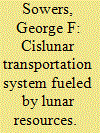

|
|
|
|
|
| Summary/Abstract |
A transportation system for a self sustaining economy in cislunar space is discussed. The system is based on liquid oxygen (LO2), liquid hydrogen (LH2) propulsion whose fuels are derived from ice mined at the polar regions of the Moon. The elements of the transportation system consist of the Advanced Cryogenic Evolved Stage (ACES) and the XEUS lander, both being developed by United Launch Alliance (ULA). The main propulsion elements and structures are common between ACES and XEUS. Both stages are fully reusable with refueling of their LO2/LH2 propellants. Utilization of lunar sourced propellants has the potential to dramatically lower the cost of transportation within the cislunar environs. These lower costs dramatically lower the barriers to entry of a number of promising cislunar based activities including space solar power. One early application of the architecture is providing lunar sourced propellant to refuel ACES for traditional spacecraft deployment missions. The business case for this application provides an economic framework for a potential lunar water mining operation.
|
|
|
|
|
|
|
|
|
|
|
|
|
|
|
|
| 2 |
ID:
148485


|
|
|
|
|
| Summary/Abstract |
Recent research has highlighted the potential of lunar resources as an important element of space exploration but their viability has not been demonstrated. Establishing whether or not they can be considered in future plans is a multidisciplinary effort, requiring scientific expertise and delivering scientific results.
To this end various space agencies and private entities are looking to lunar resources, extracted and processed in situ, as a potentially game changing element in future space architectures, with the potential to increase scale and reduce cost. However, before any decisions can be made on the inclusion of resources in exploration roadmaps or future scenarios some big questions need to be answered about the viability of different resource deposits and the processes for extraction and utilisation. The missions and measurements that will be required to answer these questions, and which are being prepared by agencies and others, can only be performed through the engagement and support of the science community.
In answering questions about resources, data and knowledge will be generated that is of fundamental scientific importance. In supporting resource prospecting missions the science community will de facto generate new scientific knowledge. Science enables exploration and exploration enables science.
|
|
|
|
|
|
|
|
|
|
|
|
|
|
|
|
| 3 |
ID:
148484


|
|
|
| 4 |
ID:
148486
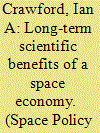

|
|
|
|
|
| Summary/Abstract |
Utilisation of the material and energy resources of the Solar System will be essential for the development of a sustainable space economy and associated infrastructure. Science will be a major beneficiary of a space economy, even if its major elements (e.g. space tourism, resource extraction activities on the Moon or asteroids, and large-scale in-space construction capabilities) are not developed with science primarily in mind. Examples of scientific activities that would be facilitated by the development of space infrastructure include the construction of large space telescopes, ambitious space missions (including human missions) to the outer Solar System, and the establishment of scientific research stations on the Moon and Mars (and perhaps elsewhere). In the more distant future, an important scientific application of a well-developed space infrastructure may be the construction of interstellar space probes for the exploration of planets around nearby stars.
|
|
|
|
|
|
|
|
|
|
|
|
|
|
|
|
| 5 |
ID:
148490


|
|
|
|
|
| Summary/Abstract |
The future of human space exploration will inevitably involve longer-term stays and possibly permanent settlement on the surfaces of other planetary bodies. It will, therefore, be advantageous or perhaps even necessary to utilise local resources for building an infrastructure for human habitation on the destination planetary body. In this context human lunar exploration is the next obvious step. Lunar soil is regarded as an ideal feedstock for lunar construction materials. However, significant gaps remain in our knowledge and understanding of certain chemical and physical properties of lunar soil, which need to be better understood in order to develop appropriate construction techniques and materials for lunar applications.
|
|
|
|
|
|
|
|
|
|
|
|
|
|
|
|
| 6 |
ID:
148487
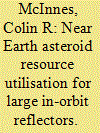

|
|
|
|
|
| Summary/Abstract |
The resources offered by the family of near Earth asteroids could provide bulk materials to support future space science ventures, both crewed missions and space-based astronomy. Using low-energy transfer trajectories small near Earth asteroids could be captured directly, or their material resources returned to Earth orbit or the Lagrange points. With novel fabrication methods, such as additive layer manufacturing, large-scale space structures including optical and radio telescopes could in principle be assembled from such resources. Indeed, with bulk materials readily available, very large numbers of structures could be fabricated in-situ for interferometry applications.
|
|
|
|
|
|
|
|
|
|
|
|
|
|
|
|
| 7 |
ID:
148491


|
|
|
|
|
| Summary/Abstract |
The concept of a space elevator dates back to Tsilokovsky, but they are not commonly considered in near-term plans for space exploration, perhaps because a terrestrial elevator would not be possible without considerable improvements in tether material. A Lunar Space Elevator (LSE), however, can be built with current technology using commercially available tether polymers. This paper considers missions leading to infrastructure capable of shortening the time, lowering the cost and enhancing the capabilities of robotic and human explorers. These missions use planetary scale tethers, strings many thousands of kilometers long stabilized either by rotation or by gravitational gradients. These systems promise major reduction in transport costs versus chemical rockets, in a rapid timeframe, for a modest investment. Science will thus benefit as well as commercial activities.
|
|
|
|
|
|
|
|
|
|
|
|
|
|
|
|
| 8 |
ID:
148489
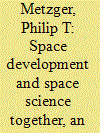

|
|
|
|
|
| Summary/Abstract |
The national space programs have an historic opportunity to help solve the global-scale economic and environmental problems of Earth while becoming more effective at science through the use of space resources. Space programs will be more cost-effective when they work to establish a supply chain in space, mining and manufacturing then replicating the assets of the supply chain so it grows to larger capacity. This has become achievable because of advances in robotics and artificial intelligence. It is roughly estimated that developing a lunar outpost that relies upon and also develops the supply chain will cost about 1/3 or less of the existing annual budgets of the national space programs. It will require a sustained commitment of several decades to complete, during which time science and exploration become increasingly effective. At the end, this space industry will capable of addressing global-scale challenges including limited resources, clean energy, economic development, and preservation of the environment. Other potential solutions, including nuclear fusion and terrestrial renewable energy sources, do not address the root problem of our limited globe and there are real questions whether they will be inadequate or too late. While industry in space likewise cannot provide perfect assurance, it is uniquely able to solve the root problem, and it gives us an important chance that we should grasp. What makes this such an historic opportunity is that the space-based solution is obtainable as a side-benefit of doing space science and exploration within their existing budgets. Thinking pragmatically, it may take some time for policymakers to agree that setting up a complete supply chain is an achievable goal, so this paper describes a strategy of incremental progress. The most crucial part of this strategy is establishing a water economy by mining on the Moon and asteroids to manufacture rocket propellant. Technologies that support a water economy will play an important role leading toward space development.
|
|
|
|
|
|
|
|
|
|
|
|
|
|
|
|
| 9 |
ID:
148488
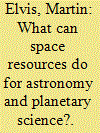

|
|
|
|
|
| Summary/Abstract |
The rapid cost growth of flagship space missions has created a crisis for astronomy and planetary science. We have hit the funding wall. For the past 3 decades scientists have not had to think much about how space technology would change within their planning horizon. However, this time around enormous improvements in space infrastructure capabilities and, especially, costs are likely on the 20-year gestation periods for large space telescopes. Commercial space will lower launch and spacecraft costs substantially, enable cost-effective on-orbit servicing, cheap lunar landers and “interplanetary cubesats” by the early 2020s. A doubling of flagship launch rates is not implausible. On a longer timescale it will enable large structures to be assembled and constructed in space. These developments will change how we plan and design missions.
|
|
|
|
|
|
|
|
|
|
|
|
|
|
|
|
|
|
|
|
|